The Massey Ferguson brand has been synonymous with building tractors for decades. It is the most popular tractor brand in Ireland, accounting for almost 20% of all tractors on our roads. In fact, we understand that Ireland is the country where the manufacturer holds its highest market share across the world.
MF has been building its tractors at the Beauvais plant in France since 1960. Today, the campus encompasses 133 acres, and 2,500 people are employed there. With over one million tractors built at the plant to date, it is responsible for the design and manufacture of the 95hp MF 4700 M right up to the flagship 405hp MF 8700 S range. The manufacturer explained it has invested €250m in the Beauvais plants in the last five years. We took a trip to the campus to find out more.
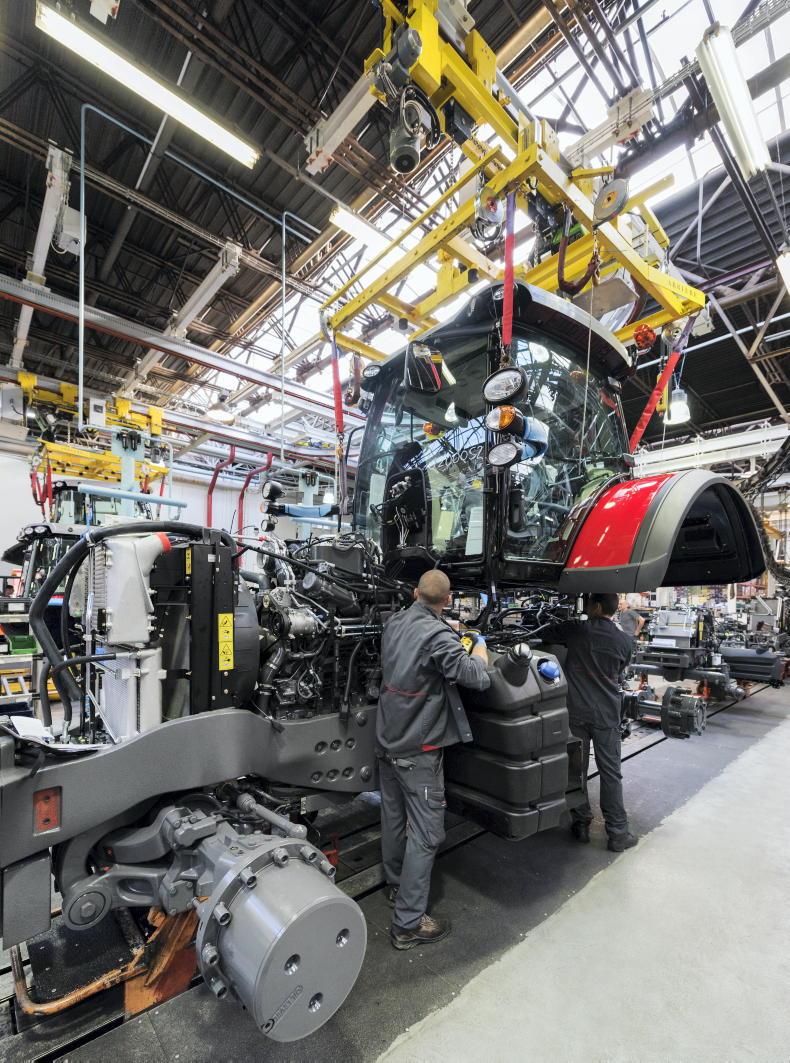
As the tractor nears the end of the assembly line, the corresponding cab is lowered dwon from above and fitted in as little as 5-7 minutes.
History
For many in Ireland, Massey Ferguson is heavily associated with Northern Irish native, Harry Ferguson who came from Dromore, Co Down. The world-famous Massey Ferguson name came about as result of the merger between Massey-Harris and the Ferguson companies in 1952. However, the company’s roots go back 105 years before that to 1847.
Before the Ferguson era, Daniel Massey, a Canadian farmer and contractor with a keen interest in engineering, decided to focus his work on machinery repairs. Shortly after, he began manufacturing mowers, reapers and binders. With business going well, a foundry was established in 1847 in Ontario, Canada. This was home to what was named the Massey Manufacturing Company.
Following reclamation of the prairies and forestry into farmland in the late 19th century, a demand for farm machinery had been created, resulting in a rapid growth for Massey’s company. In 1891, after fierce rivalry with competitors A Harris, Son and Company, also based in Ontario, the companies merged to form Massey-Harris Limited. Harris had further diversified and started manufacturing ploughs and steam tractors by the turn of the century.

Three different era's of Massey Ferguson models on display inside the Technology Centre
After no great success importing and selling tractor brands such as the Whiting Bull, the Massey-Harris group decided to design and start building its own tractor models in 1928 and went on to produce one of the world’s first 4WD tractors.
Ferguson
Renowned as a genius inventor, Harry Ferguson found tractors up until the 1920s had been designed too much as a direct replacement for a horse and that the implement coupling system went largely unchanged. So he designed the Ferguson System. While largely similar to the three-point linkage we know today, it was designed as a more rigid and integrated method of coupling implements hydraulically. In 1936, Ferguson launched the successful Ferguson Brown tractor which had been built by the David Brown Company. Ferguson later started manufacturing tractors at Banner Lane, Coventry in 1946.
By the 1950s, Massey-Harris had a factory in Scotland manufacturing tractors and combines. However, business began to slow while the Ferguson brand was going from strength to strength. In 1953, Massey-Harris bought Ferguson’s tractor brand to form Massey-Harris-Ferguson. The name was shortened four years later to Massey Ferguson. Production remained at Banner Lane where it stayed until 2002 when it moved to Beauvais, ending an era after 56 years and more than three million tractors.
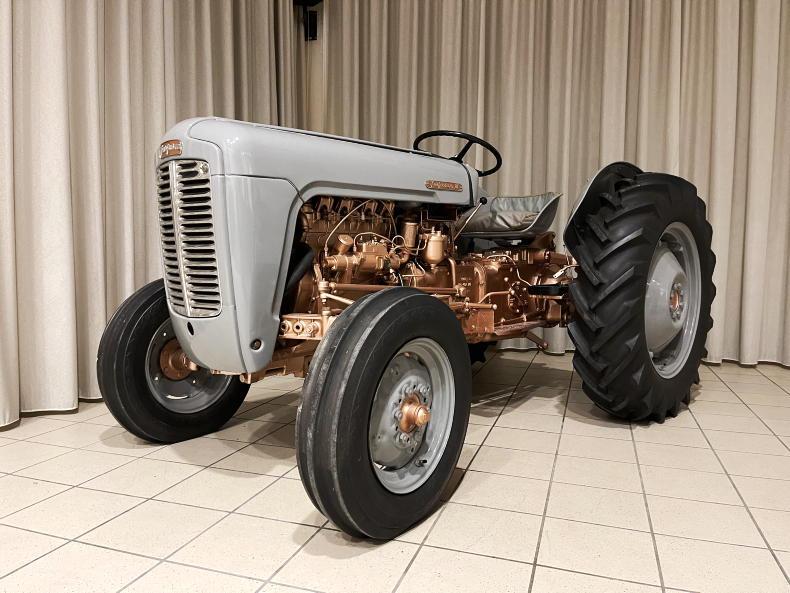
The famous Ferguson FE35 Gold Belly.
In 1994, Massey Ferguson was acquired by AGCO. This year the brand celebrated the 175th anniversary of Daniel Massey’s first foundry with the introduction of its new modern logo.
The factory
The AGCO campus in Beauvais is 75km north of Paris and is split into four sites, labelled 1-4. We toured Beauvais 1, which is home to the main assembly line with quality control and testing, and also houses GIMA.
For those unaware, GIMA develops and builds powershift transmissions and rear axles for tractors, ranging from 55hp up to 620hp. GIMA is a 50-50 joint venture between AGCO and Claas. The manufacturer claims that its transmissions are fitted to more than 400,000 tractors worldwide.
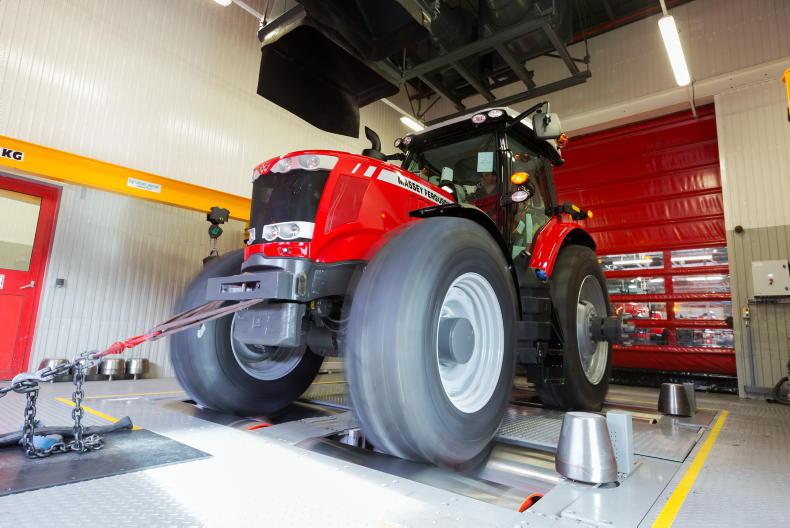
Every tractor spends time on one of three rolling roads undergoing a list of computer-generated tasks to ensure all functions are within tolerance.
The Beauvais 1 site opened on 22 November 1960. There have been over one million MF tractors built at the plant since the first 800 series tractor rolled off the line. It houses the R&D departments and the assembly lines for tractors ranging from 75hp to 400hp. It centres Massey Ferguson’s European operations department in addition to the purchasing, legal, IT and human resources departments.
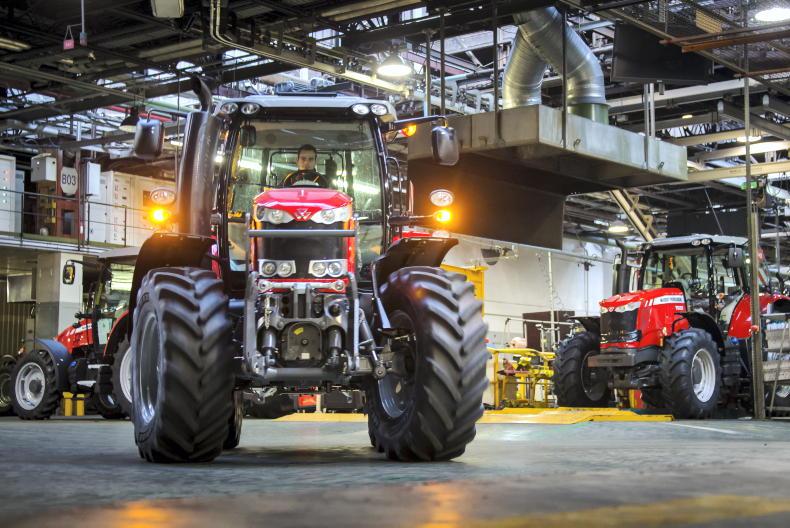
Once fully assembled tractors are drove of the line to undergo final testing.
Beauvais 2 is where the manufacturer builds its cabs. This plant was opened in 2013, and was designed to give the manufacturer greater control of cab manufacturing. The factory can produce up to 100 cabs daily for MF, Valtra and Iseki. This cab assembly line can cater for 24 cabs at the one time. Once built, each cab is tested on a simulator, by an automated process, before being delivered to the nearby tractor assembly operation. The Beauvais 2 site also doubles as an international sales training centre for Massey Ferguson and the European centre for AGCO Finance.
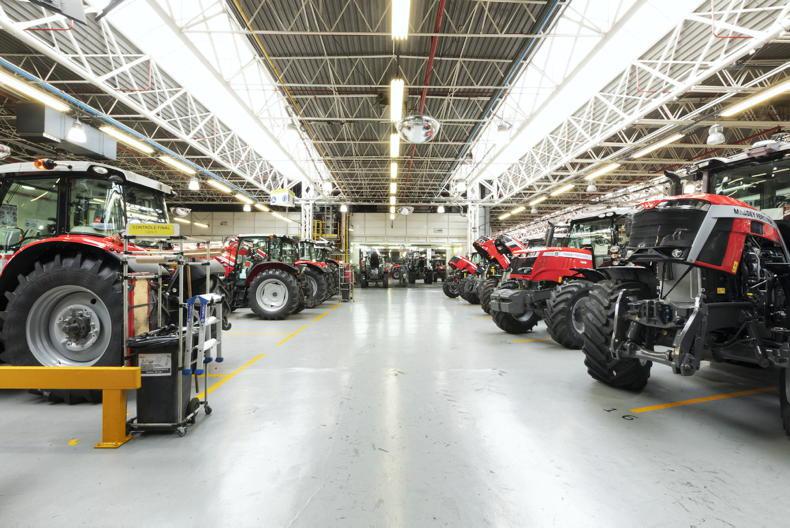
Final touches and inspection take place before each tractor is tested on a rolling road.
Beauvais 3 was opened in September 2018 and looks after logistics and spare parts for the Beauvais production sites. It is spread over an area of 30,000m² and is designed to streamline component supply logistics.
Beauvais 4 is the latest addition to the campus, and is said to be at the forefront of industry 4.0. Opened in September 2019, the €40m investment included the purchasing of a nearby 15.7ha site. Here, works such as manufacturing for small series parts and prototypes to support the customisation workshop, in-house production of hydraulic pipes, tractor customisation and 3D printing all take place.
The manufacturing process
Beauvais 1 is home to the single 500m assembly line. Here, over 30 models ranging from 75hp to 400hp are assembled. On average, it takes a tractor nine hours to make it through the factory from the first steps of assembly right through to final testing. The main assembly line continually moves through 96 stations, and is designed to turn out 96 completed tractors daily. When we visited, the build quota for the day was 84 tractors.
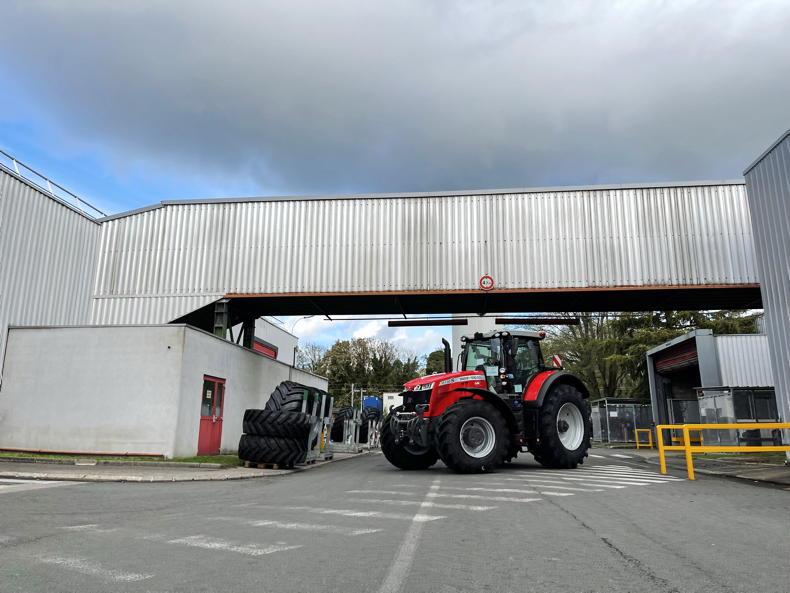
A freshly built 8730 S rolling out of the factory.
All components for each of the dedicated sub-assemblies arrive from Beauvais 3 to Beauvais 1 in kit form. These kit trolleys can be seen all over the plant and contain the exact number of components to form the associated sub-assembly. Every tractor on the line is built to order, meaning no tractor is built for stock. This means specific kits are assembled for each tractor in the corresponding sequence. Beauvais 3 stores 800 engines and 9,000 different types of components at any one time.
Labour is split 65-35 on sub-assembly v assembly. The main assembly line operates a seven-hour shift, five days each week.
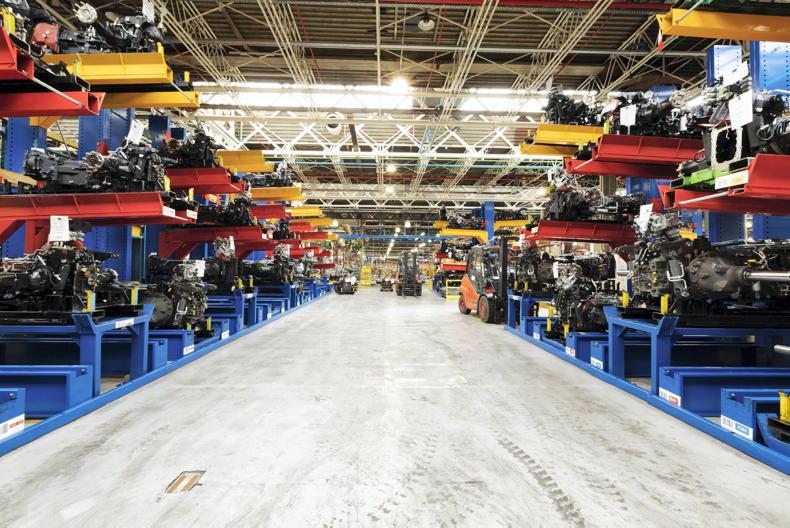
GIMA builds powershift transmissions and rear axles for tractors, ranging from 55hp up to 620hp.
The process is comparable to a fish spine, with the main assembly line being the backbone and each of the sub assembly areas serving as the smaller bones feeding into the backbone. To aid efficiency, each sub assembly is built right beside where it is then married to the moving chassis.
One thing we noticed with the assembly line was the sequence in which tractors were built. It wasn’t a case of the same models being assembled in a row. Instead, it was from one extreme to another in terms of spec and size. This, Massey says, helps the smooth running of the assembly line. The logic is simple – a smaller horsepower basic tractor takes less time at each station compared to a more complex larger 400hp tractor, allowing operators to balance their time accordingly.
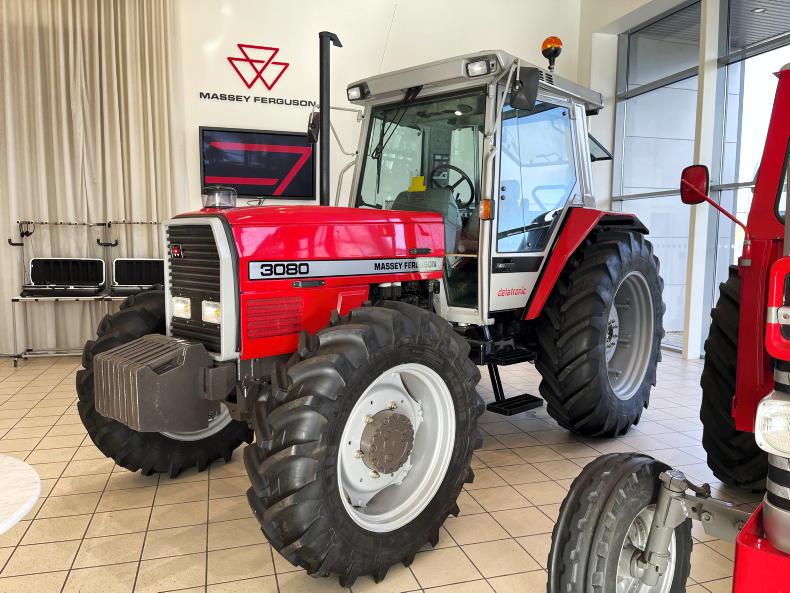
A 3080 model from the 1990's inside the Technology Centre.
Sixteen to 17 shuttles each day transport the completed cabs the 2km from Beauvais 2 to the assembly line. Every chassis is engraved with information such as the year of production, the location of production, the day and what stage of the day that particular tractor was built.
GIMA
A proportion of the Beauvais 1 facility is home to GIMA. As already stated, GIMA originated in 1994 as a joint venture between AGCO and Renault (now Claas). It’s here the rear axles and Dyna 4, and Dyna 6 transmissions are made for MF and Hexashift transmissions are built for Claas. Over the past three to five years, GIMA has undergone a €50m investment in new machinery including the installation of two new heat treatment stations which allows up to 24,000 transmissions to be manufactured annually.
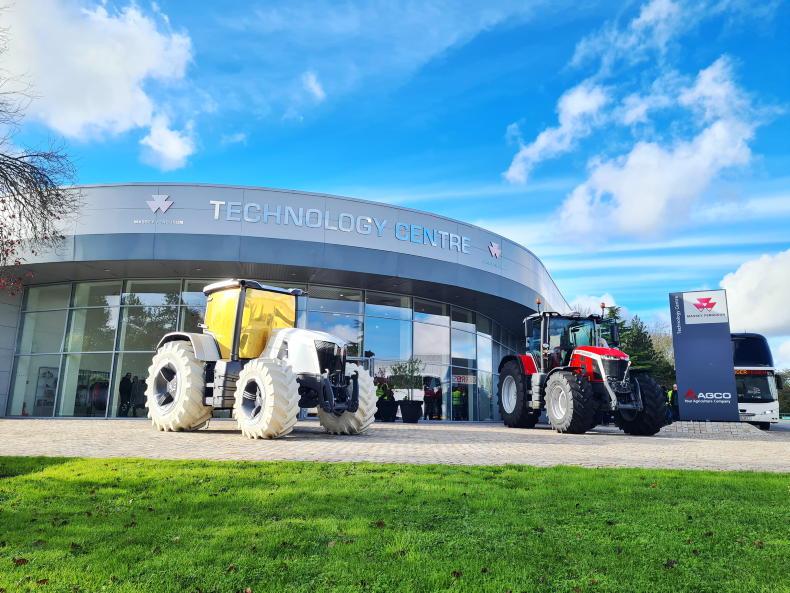
The 8S.205 parked beside the Next Concept tractor that was displayed at Agritechnica in 2019.
All transmission housings arrive at GIMA as bare cast units before they each undergo two hours of robotic machining. Similar to the rest of the factory, each of the transmission sub-assemblies are made alongside the main line and are married together at the corresponding stages. Roughly 50% of the transmissions built daily are for MF while the remaining 50% is split between Claas and Valtra.
MF also looks after the production of its own hydraulic components and the printing of its stickers. More recently, it started manufacturing its own fuel and AdBlue tanks with the goal of being able to provide tanks for all AGCO facilities in Europe. Primer and paint are applied through robotics, but is inspected using the human eye. Once painted, the tractors are baked at 80°C in an oven for 30 minutes.
As tractors near completion on the line, the cabs are fitted in as little as five to seven minutes. After this, fluids such as diesel, oil and AdBlue etc are added before fitting the bonnet and correct wheel combinations. A total of 600 tyre/rim options are offered by the plant.

Steering colums being produced inside Beauvais 2.
An operator inside the cab ensures everything is functioning before firing the tractor into life for the first time. After this, every tractor is validated via a list of computer-generated tasks on one of three rolling roads, making sure everything is operational and within tolerance. MF explained that 3-4% of total production is thoroughly audited, going through 900 points of inspection.
Most popular models and markets
In 2021, AGCO built 13,254 tractors at the campus in Beauvais which were supplied to 140 countries. Of this, 97.5% were Massey Ferguson with the remainder being other brands such as Valtra. For those unaware, the high-horsepower Valtras, namely the new Q Series, are also built at the Beauvais plant.
While the 3080 model was dubbed the bestseller of the 1990s, the 5711 M is the most popular model today, followed by the 7718S Dyna 6 and followed thirdly by the 7719S DVT. According to the manufacturer, CVT transmissions today account for one-third of production. The domestic market in France is the manufacturer’s main market, accounting for 15% of its annual production.
Beauvais key facts
Beauvais site covers 133ac. MF employs 2,500 staff at Beauvais. 30 models built from 95hp to 405hp. Capacity to build up to 96 tractors daily. Main assembly line is 500m long with 96 stations. 2022 marked the one millionth tractor produced in Beauvais. 5711 M was the best seller in 2021 with 951 units built.
The Massey Ferguson brand has been synonymous with building tractors for decades. It is the most popular tractor brand in Ireland, accounting for almost 20% of all tractors on our roads. In fact, we understand that Ireland is the country where the manufacturer holds its highest market share across the world.
MF has been building its tractors at the Beauvais plant in France since 1960. Today, the campus encompasses 133 acres, and 2,500 people are employed there. With over one million tractors built at the plant to date, it is responsible for the design and manufacture of the 95hp MF 4700 M right up to the flagship 405hp MF 8700 S range. The manufacturer explained it has invested €250m in the Beauvais plants in the last five years. We took a trip to the campus to find out more.

As the tractor nears the end of the assembly line, the corresponding cab is lowered dwon from above and fitted in as little as 5-7 minutes.
History
For many in Ireland, Massey Ferguson is heavily associated with Northern Irish native, Harry Ferguson who came from Dromore, Co Down. The world-famous Massey Ferguson name came about as result of the merger between Massey-Harris and the Ferguson companies in 1952. However, the company’s roots go back 105 years before that to 1847.
Before the Ferguson era, Daniel Massey, a Canadian farmer and contractor with a keen interest in engineering, decided to focus his work on machinery repairs. Shortly after, he began manufacturing mowers, reapers and binders. With business going well, a foundry was established in 1847 in Ontario, Canada. This was home to what was named the Massey Manufacturing Company.
Following reclamation of the prairies and forestry into farmland in the late 19th century, a demand for farm machinery had been created, resulting in a rapid growth for Massey’s company. In 1891, after fierce rivalry with competitors A Harris, Son and Company, also based in Ontario, the companies merged to form Massey-Harris Limited. Harris had further diversified and started manufacturing ploughs and steam tractors by the turn of the century.

Three different era's of Massey Ferguson models on display inside the Technology Centre
After no great success importing and selling tractor brands such as the Whiting Bull, the Massey-Harris group decided to design and start building its own tractor models in 1928 and went on to produce one of the world’s first 4WD tractors.
Ferguson
Renowned as a genius inventor, Harry Ferguson found tractors up until the 1920s had been designed too much as a direct replacement for a horse and that the implement coupling system went largely unchanged. So he designed the Ferguson System. While largely similar to the three-point linkage we know today, it was designed as a more rigid and integrated method of coupling implements hydraulically. In 1936, Ferguson launched the successful Ferguson Brown tractor which had been built by the David Brown Company. Ferguson later started manufacturing tractors at Banner Lane, Coventry in 1946.
By the 1950s, Massey-Harris had a factory in Scotland manufacturing tractors and combines. However, business began to slow while the Ferguson brand was going from strength to strength. In 1953, Massey-Harris bought Ferguson’s tractor brand to form Massey-Harris-Ferguson. The name was shortened four years later to Massey Ferguson. Production remained at Banner Lane where it stayed until 2002 when it moved to Beauvais, ending an era after 56 years and more than three million tractors.

The famous Ferguson FE35 Gold Belly.
In 1994, Massey Ferguson was acquired by AGCO. This year the brand celebrated the 175th anniversary of Daniel Massey’s first foundry with the introduction of its new modern logo.
The factory
The AGCO campus in Beauvais is 75km north of Paris and is split into four sites, labelled 1-4. We toured Beauvais 1, which is home to the main assembly line with quality control and testing, and also houses GIMA.
For those unaware, GIMA develops and builds powershift transmissions and rear axles for tractors, ranging from 55hp up to 620hp. GIMA is a 50-50 joint venture between AGCO and Claas. The manufacturer claims that its transmissions are fitted to more than 400,000 tractors worldwide.

Every tractor spends time on one of three rolling roads undergoing a list of computer-generated tasks to ensure all functions are within tolerance.
The Beauvais 1 site opened on 22 November 1960. There have been over one million MF tractors built at the plant since the first 800 series tractor rolled off the line. It houses the R&D departments and the assembly lines for tractors ranging from 75hp to 400hp. It centres Massey Ferguson’s European operations department in addition to the purchasing, legal, IT and human resources departments.

Once fully assembled tractors are drove of the line to undergo final testing.
Beauvais 2 is where the manufacturer builds its cabs. This plant was opened in 2013, and was designed to give the manufacturer greater control of cab manufacturing. The factory can produce up to 100 cabs daily for MF, Valtra and Iseki. This cab assembly line can cater for 24 cabs at the one time. Once built, each cab is tested on a simulator, by an automated process, before being delivered to the nearby tractor assembly operation. The Beauvais 2 site also doubles as an international sales training centre for Massey Ferguson and the European centre for AGCO Finance.

Final touches and inspection take place before each tractor is tested on a rolling road.
Beauvais 3 was opened in September 2018 and looks after logistics and spare parts for the Beauvais production sites. It is spread over an area of 30,000m² and is designed to streamline component supply logistics.
Beauvais 4 is the latest addition to the campus, and is said to be at the forefront of industry 4.0. Opened in September 2019, the €40m investment included the purchasing of a nearby 15.7ha site. Here, works such as manufacturing for small series parts and prototypes to support the customisation workshop, in-house production of hydraulic pipes, tractor customisation and 3D printing all take place.
The manufacturing process
Beauvais 1 is home to the single 500m assembly line. Here, over 30 models ranging from 75hp to 400hp are assembled. On average, it takes a tractor nine hours to make it through the factory from the first steps of assembly right through to final testing. The main assembly line continually moves through 96 stations, and is designed to turn out 96 completed tractors daily. When we visited, the build quota for the day was 84 tractors.

A freshly built 8730 S rolling out of the factory.
All components for each of the dedicated sub-assemblies arrive from Beauvais 3 to Beauvais 1 in kit form. These kit trolleys can be seen all over the plant and contain the exact number of components to form the associated sub-assembly. Every tractor on the line is built to order, meaning no tractor is built for stock. This means specific kits are assembled for each tractor in the corresponding sequence. Beauvais 3 stores 800 engines and 9,000 different types of components at any one time.
Labour is split 65-35 on sub-assembly v assembly. The main assembly line operates a seven-hour shift, five days each week.

GIMA builds powershift transmissions and rear axles for tractors, ranging from 55hp up to 620hp.
The process is comparable to a fish spine, with the main assembly line being the backbone and each of the sub assembly areas serving as the smaller bones feeding into the backbone. To aid efficiency, each sub assembly is built right beside where it is then married to the moving chassis.
One thing we noticed with the assembly line was the sequence in which tractors were built. It wasn’t a case of the same models being assembled in a row. Instead, it was from one extreme to another in terms of spec and size. This, Massey says, helps the smooth running of the assembly line. The logic is simple – a smaller horsepower basic tractor takes less time at each station compared to a more complex larger 400hp tractor, allowing operators to balance their time accordingly.

A 3080 model from the 1990's inside the Technology Centre.
Sixteen to 17 shuttles each day transport the completed cabs the 2km from Beauvais 2 to the assembly line. Every chassis is engraved with information such as the year of production, the location of production, the day and what stage of the day that particular tractor was built.
GIMA
A proportion of the Beauvais 1 facility is home to GIMA. As already stated, GIMA originated in 1994 as a joint venture between AGCO and Renault (now Claas). It’s here the rear axles and Dyna 4, and Dyna 6 transmissions are made for MF and Hexashift transmissions are built for Claas. Over the past three to five years, GIMA has undergone a €50m investment in new machinery including the installation of two new heat treatment stations which allows up to 24,000 transmissions to be manufactured annually.

The 8S.205 parked beside the Next Concept tractor that was displayed at Agritechnica in 2019.
All transmission housings arrive at GIMA as bare cast units before they each undergo two hours of robotic machining. Similar to the rest of the factory, each of the transmission sub-assemblies are made alongside the main line and are married together at the corresponding stages. Roughly 50% of the transmissions built daily are for MF while the remaining 50% is split between Claas and Valtra.
MF also looks after the production of its own hydraulic components and the printing of its stickers. More recently, it started manufacturing its own fuel and AdBlue tanks with the goal of being able to provide tanks for all AGCO facilities in Europe. Primer and paint are applied through robotics, but is inspected using the human eye. Once painted, the tractors are baked at 80°C in an oven for 30 minutes.
As tractors near completion on the line, the cabs are fitted in as little as five to seven minutes. After this, fluids such as diesel, oil and AdBlue etc are added before fitting the bonnet and correct wheel combinations. A total of 600 tyre/rim options are offered by the plant.

Steering colums being produced inside Beauvais 2.
An operator inside the cab ensures everything is functioning before firing the tractor into life for the first time. After this, every tractor is validated via a list of computer-generated tasks on one of three rolling roads, making sure everything is operational and within tolerance. MF explained that 3-4% of total production is thoroughly audited, going through 900 points of inspection.
Most popular models and markets
In 2021, AGCO built 13,254 tractors at the campus in Beauvais which were supplied to 140 countries. Of this, 97.5% were Massey Ferguson with the remainder being other brands such as Valtra. For those unaware, the high-horsepower Valtras, namely the new Q Series, are also built at the Beauvais plant.
While the 3080 model was dubbed the bestseller of the 1990s, the 5711 M is the most popular model today, followed by the 7718S Dyna 6 and followed thirdly by the 7719S DVT. According to the manufacturer, CVT transmissions today account for one-third of production. The domestic market in France is the manufacturer’s main market, accounting for 15% of its annual production.
Beauvais key facts
Beauvais site covers 133ac. MF employs 2,500 staff at Beauvais. 30 models built from 95hp to 405hp. Capacity to build up to 96 tractors daily. Main assembly line is 500m long with 96 stations. 2022 marked the one millionth tractor produced in Beauvais. 5711 M was the best seller in 2021 with 951 units built. 
















 This is a subscriber-only article
This is a subscriber-only article








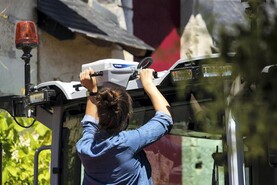
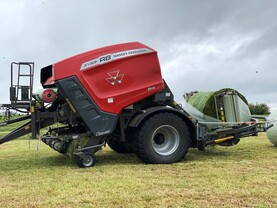
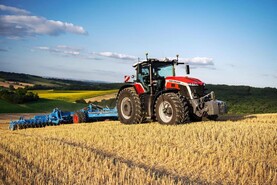

SHARING OPTIONS: